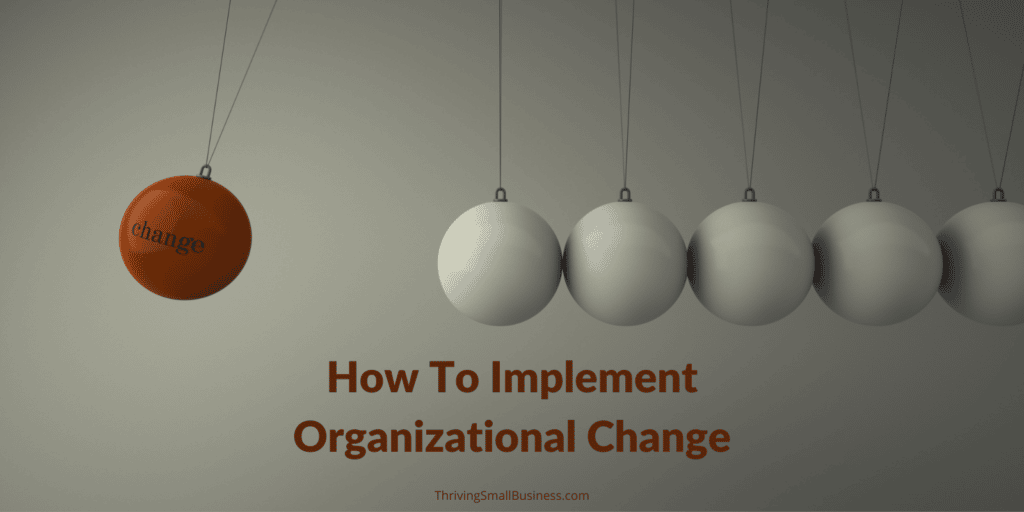8 Steps to Implementing Organizational Change
Estimated reading time: 6 minutes
Change is a word that generates uneasiness and sometimes fear in most of us. However, successful organizations understand that when they are doing things the same way with poor results, implementing organizational change can be necessary.
But most would agree that we can think of a time when we had a good life change.
What Is A Good Change?
A marriage, the birth of a baby, moving into a new home, or a new job are examples of positive changes in our lives. So why is it so difficult to swallow change at work?
Anyone who has ever gone into an organization and tried to change “the way things are” understands the resistance employees can have against any change effort.
Even Small Changes Can Produce Resistance
I worked for an organization that was implementing some change, and we started the process by asking the staff to read this book:
Who Moved My Cheese?: An Amazing Way to Deal with Change in Your Work and in Your Life by Dr. Spencer Johnson.
The book was simply a way to help employees think about change differently and hopefully embrace some of the changes we were getting ready to make.
It was sadly comical how resistant the staff was to just the mention of change.
There was a woman who participated in the training that we later moved from a very small cubicle to a large, shared office with privacy and new furniture.
We expected her to be excited about (what we thought would be) a good change for her – however, she viewed it very differently.
She was very upset and expressed that she didn’t “like that we moved her cheese.”
Ironically, months later, she recognized the benefit of the move and thanked us.
This is just a simple example of how seemingly small things for some people can be very upsetting to others.
Doing Things The Same Way Will Produce The Same Results
Some people get set in their ways, get comfortable, and resist change because it causes them to undo comfortable habits.
However, successful organizations understand that doing things the same way will produce the same result.
And that sometimes change is needed to take an organization to the next level.
“The definition of Insanity: doing the same thing over and over again and expecting different results.” Albert Einstein
So whether the change is looking for ways to improve cash flow, transitioning to a new software program, adhering to new policies and procedures for processing material, an office move, or a change in an employee benefit plan, successful change happens when it is managed.
So why do people resist change?
Often it is fear of the unknown or perhaps how the change will impact them.
When people don’t know all the answers, they feel like they have lost control, and that makes them feel hopeless.
Organizational leaders have the responsibility to manage change efforts to minimize the negative impact on employees.
To effectively manage change efforts, it is important to help people understand what the change will be and the reasons behind the change.
The more detailed the communication about the vision for the change, the better employees understand the need and the less resistant they will be to the change.
8 Steps to Implementing Change
1. Management Support for Change
Employees develop a comfort level when they see management support the process.
It is crucial that management shows support for changes and demonstrates that support when communicating and interacting with staff.
There is nothing worse than sending a mixed message to employees.
If you can’t support the change 100%, don’t even think about making it. Employees will know it, and the change initiative will fail.
2. Make the Case for Change
No one wants to change for change’s sake, so it is important to create a case for change.
A case for change can come from different sources.
Use data to determine change efforts.
For instance, use data collected on defect rates, customer satisfaction surveys, employee satisfaction surveys, customer comment cards, business goals as a result of a strategic planning session, or budget pressures.
The most effective changes come when using data to identify and justify areas that need improvement.
3. Encourage Employee Involvement
All change efforts should involve employees at some level.
Employees are the ones affected the most by operational changes. This reality makes it important that they understand the why behind a change and participate in creating the new process.
For instance, if your office is upgrading its phone systems, the receptionist should be part of the team that identifies, tests, and selects new equipment.
Organizational change, whether large or small, needs to be explained and communicated, specifically changes that affect how employees perform their jobs.
Whether it is changing a work process, improving customer satisfaction, or finding ways to reduce costs, employees have experiences that can benefit the change planning and implementation process.
4. Communicating the Change
Employees are at the mercy of management to inform them of changes.
The process of communicating change should be structured and systematic.
A poor communication process will spark a rumor mill that will spread inaccurate information about a planned change. This miscommunication can create a tide of resistance to the change.
Proactive communication can minimize resistance and make employees feel like they are part of the process.
5. Strategic Implementation
After a change is planned, it is important to have good communication about the roll-out and implementation of the change.
Create a timeline for the implementation. Planned changes should be made in the order of their impact on the process and the employees who manage that process.

For instance, if your organization is upgrading its software program, employee training should be done before the software is installed on their computers.
An effective timeline will allow for all new equipment, supplies, or training to take place before it is fully implemented.
Implementing without a logical order can create frustration for those responsible for the work process.
6. Follow-up After Implementation
Whenever a change is made, it is always good to follow up after implementation.
This is the perfect time to assess how the change is working and if the change delivered the intended results.
Sometimes, changes exceed target expectations. However, there are occasions when changes just don’t work as planned.
When this is the case, management should acknowledge that the change didn’t produce the expected results and make adjustments until the desired result is achieved.
7. Remove Barriers to Implementation
Sometimes, employees encounter barriers when attempting to implement change.
Barriers can be other employees, other departments, inadequate training, lacking equipment, or supply needs.
Occasionally, management also needs to deal with resistant or difficult employees.
For instance, if you encounter an employee who refuses to adjust to new processes, procedures, or software updates, be direct and manage them through the change or help them move on.
It is the management’s responsibility to ensure that employees can implement change without obstacles and resistance.
It is unfortunate, but there are times when employees simply can’t accept a change. In these rare cases, employees simply need to move on to successfully implement a needed change. These are difficult but necessary decisions.
8. Celebrate Success
Celebrate successes as changes are made.
When you celebrate small changes, you will be building momentum for bigger changes and make employees want to participate in the process.
Make the celebration of success part of your culture!
Employee Buy-In Is Crucial To Successful Change
When employees understand why a change is made and are part of the process for planning and implementing the change, it allows for a better chance for successful implementation.
If you would like to learn more about managing change in your organization, John Kotter has a great book, Leading Change, With a New Preface, that I highly recommend.






